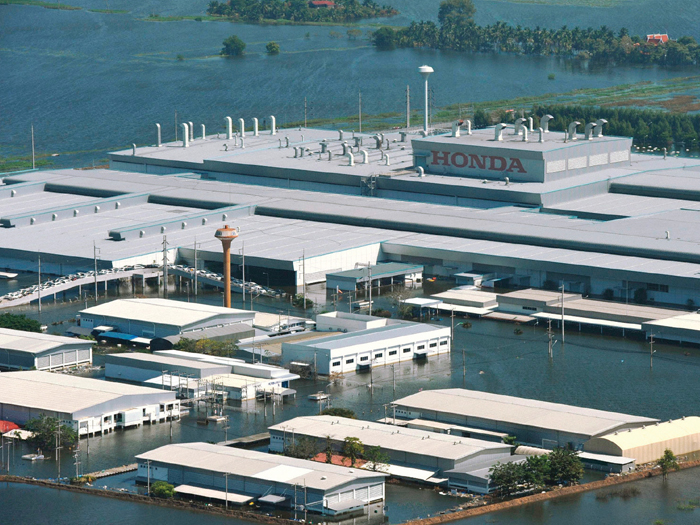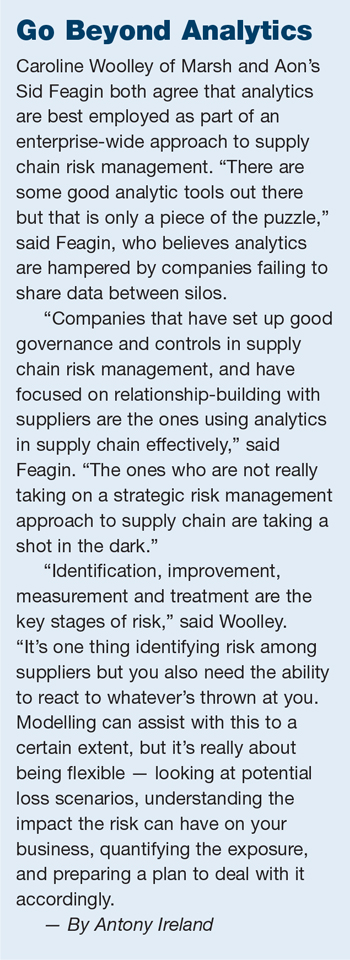Supply Chain
An Eye on the Chain

Supply chain risk had been steadily escalating for the last few decades, but it took natural disasters in Japan and Thailand in 2011 to bring the true extent of the risk to the surface.
In addition to the enormous financial and human losses suffered in those countries, businesses around the globe faced major disruption as key suppliers were wiped out and supply chains ground to a halt.
It was a harsh wake-up call.
“The events in Japan and Thailand really gave rise to a realization of how much greater the risk in people’s supply chains is today than 10 or 20 years ago,” said David Shillingford, senior vice president, supply chain solutions for Verisk Analytics.
“Supply chains have become more efficient — thinner, longer — but in many ways less resilient.”
Video: Supply chain risk management as discussed at the University of Bath.
In the automotive industry, for example, there are significant interdependencies regarding raw materials and parts. The Japanese tsunami wiped out essential component manufacturers and halted car production around the globe.
Meanwhile, added Shillingford: “Supply chain disruption in the pharmaceutical industry can be very costly because of the value of the ingredients, and in both pharmaceuticals and food there are evolving compliance risks to consider too.”
In fact, in today’s interconnected world, almost all industries are affected by supply chain risk. And as an increasing amount of production is farmed out to specialist manufacturers — often in emerging markets — risk is becoming more concentrated.
Sid Feagin, director, enterprise risk management, Aon Risk Solutions, noted that it is now common for firms across many industries to farm out 85 percent or more of their core product to a long chain of suppliers.
“In many cases the risks associated with this are uninsurable, which makes the management of supply chain risk paramount to the success of an organization,” he said.
A Lack of Visbility
However, gaining visibility into the risks of suppliers deep into a complex supply chain is extremely difficult, and many companies have turned to analytic software for help.
“A lot of businesses have a pretty good grip on their direct suppliers, but it’s the second, third, fourth tiers in their supply chains where there is a gap in knowledge and information and an accumulation of risk,” said Caroline Woolley, leader of Marsh’s global business interruption center of excellence.
Computer manufacturer Lenovo uses suppliers from all around the world. According to Mick Jones, the firm’s vice president of supply chain strategy worldwide, analytics have become an essential risk management tool in addition to improving business efficiency. So much so that the firm has created a role akin to a “chief analytics officer,” running analytics teams stationed around the world, he said.
“Analytics offers massive value to the business. We are at a start of the journey of using analytics to help us focus on risk. We are investing a lot of time in getting product visibility and order visibility along the entire supply chain, which is an area we can always improve on,” said Jones.
Jones explained that analytics have become essential given the volatile environment of the last five years characterized by natural disasters, socio-economic unrest and financial instability.
“The algorithms in the software are becoming more intuitive and intelligent, so you are able to do more with data and analytics,” he said.
“In four years, we’ve moved from a very ‘descriptive’ analytics approach — reporting, scorecards, dashboards — through to a more ‘prescriptive’ approach, using simulation and optimization tools to almost predict what is going to happen going forward.”
However, meaningful data on supply chain risk is patchy because a great deal of supply chain risk is not insured and companies typically don’t keep detailed records of their losses. Such risk historically fell between the cracks as far as insurers were concerned, but the last decade has seen a number of specialist products emerge to protect companies against these risks.
“These losses were treated almost as operational risk, which was something companies had to deal with on daily basis, so they weren’t recorded,” said Woolley.
“As we are seeing more of these incidents and getting more data on the impact of supply chain risk, we are seeing a lot more interest in alternative supply chain policies.”
Shillingford said that analytics being developed by Verisk could make it easier for both companies and insurers to identify and calculate the impact of supplier risks more accurately.
“We want to encourage ‘risk-adjusted supply chain optimization.’ Often, supply chain optimization focuses only on efficiency, but we rarely hear people talk about risk and resiliency. In order to do that you have to put a value against the risk,” he said.
“The events in Japan and Thailand really gave rise to a realization of how much greater the risk in people’s supply chains is today than 10 or 20 years ago.” — David Shillingford, senior vice president, supply chain solutions, Verisk Analytics.
“The chasm between the amount of risk not insured at the present time and the amount of capital available to be deployed to insure supply chain risk [results from a] lack of visibility into the risk. If we are able to provide that visibility it could be the biggest risk transfer opportunity of the next 10 years.”
Tracking Insolvency Risk
While data on weather or catastrophe-related supply chain losses is increasingly abundant, it is far more difficult to track the risk of insolvency within a supply chain in real time. The financial data of companies is released sporadically and can be incomplete. Given the precarious nature of the economy since 2008, the risk of suppliers going bust is very real.
“Insolvency is a significant risk but it may be near impossible to fully understand,” said Feagin. “The key to understanding whether a supplier is solvent or not comes down to access of information.
“I see companies relying on various sources of information which may be too old or inaccurate to draw relevant conclusions from.”
According to Shillingford, while there are a variety of companies that offer services to assess financial strength, “each has a different methodology, usually expressed as a score, and all face similar challenges obtaining financial data for suppliers to their client’s suppliers.”
Indeed, the software industry has yet to develop an approach that can map solvency risk in real time.
Jones said that analytics play virtually no role in mitigating insolvency risk in Lenovo’s supply chain. “We deal with global suppliers who are based in many parts of the world and the data is difficult to get, but we do have a very sound supplier management approach that allows us to identify issues earlier and more collaboratively.”
Feagin said it’s crucial for companies to focus on their relationships with their suppliers, rather than just crunching numbers.
“In order to get these numbers you need to build up a relationship and trust with the suppliers. Without a strong relationship, you don’t have much power to gain information.
“There is not a piece of software out there that can tell you whether or not to do business with a particular vendor — it comes down to taking a strategic and focused approach to managing supply chain risk.”
He also noted that companies add uncertainty to their supply chains by failing to pay their suppliers promptly.
“The greatest insurance [against insolvency risk in the supply chain] is being a prompt payer and having a good relationship with suppliers,” he said.












